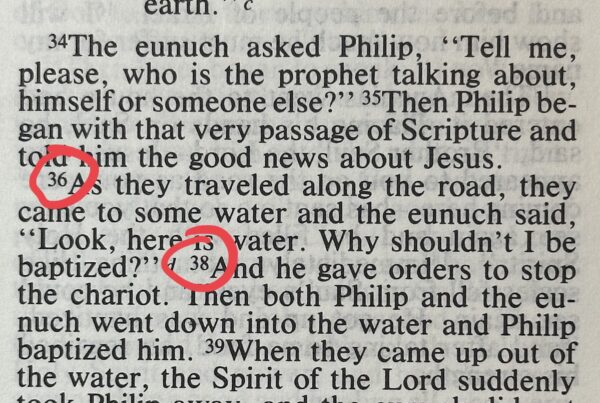- The texts of the Bible. While the Bible presents one overarching story, it is not just one book. It is a collection of 66 books (the Protestant version) produced by about 40 different authors over a period of about 1500 years. No one believes that we have the original of any of these books; we only have copies. However, the textual evidence is overwhelming in terms of attesting to our confidence that the copies we have are close to the originals. We have over 5,700 texts of biblical material during the first four centuries (compared to 7 ancient copies for Plato and 10 ancient copies of Caesar’s Gallic Wars). Some copies of New Testament first-century books or portions of them go back into the 2nd century.
- The reliability of the copying process was remarkable. This is illustrated by the Dead Sea Scrolls (DSS) that were discovered in the 1940s. Among the documents was a scroll of Isaiah. Previously, the oldest copy we had of Isaiah dated back to the early AD900s. The DDS, however, were dated to about 100BC. How accurate was the copying during the intervening 1,000 years? Basically, 95% of the text was identical, and the differences were little more than spelling variations. (See this article for further information.)
- The dates of the original materials and the events described. For reference, let’s say that Jesus’ death and resurrection were in AD30 (rather than AD33). The earliest New Testament books come from the apostle Paul, with Galatians and 1 & 2 Thessalonians around AD48-52. 1 Corinthians, which includes the notable “resurrection chapter” (ch. 15), was likely written by AD56. The four Gospels (Matthew, Mark, Luke, and John) were written before AD100; and some scholars have argued that they were completed before AD70, because they make no mention of one of the most significant events in the history of the Jews (and Christians) in the first century—the destruction of Jerusalem by the Romans in AD70. This evidence is amazing by ancient standards. (Remember, there was no FaceBook or Twitter to give instant updates. Their fastest mode of communication was to go in person or to disseminate information orally.)
- Archaeological connections. Modern archaeological discoveries have confirmed many places, names, events, and terms that are mentioned in the Bible. Some include the Black Obelisk of Shalmaneser III (2 Kings 9-10), Sennacherib’s Prism (2 Kings 18-19; 2 Chronicles 32), the Cyrus Cyllinder (Ezra 1:1-3; 6:3), the Pilate Stone (Luke 3:1), the Pool of Bethesda (John 5:1-5), and the Caiaphas Ossuary (John 18:13-28). See this article for a list of biblical artifacts.
For more, click here or see History Room of our guided tour through a Christian house.





